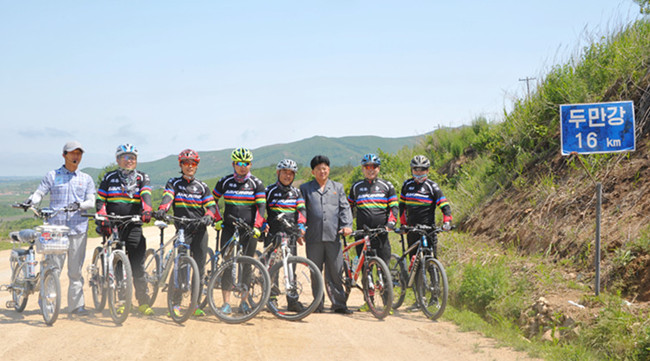On two wheels from the back of beyond and back
 |
|
Cyclists from Hunchun Bicycle Club take a break 16 km from the Tumen River. [Photo provided to China Daily] |
It does not get much more off the beaten track than this. Snuggled between three countries - China, the Democratic People's Republic of Korea (DPRK) and Russia - in the extreme southeast of Jilin province in Northeast China, is a city called Hunchun.
The city, whose name roughly translates as fine jade spring, and which some have dubbed the gateway to Japan, is small by Chinese standards, with a population of just 250,000. Its location in the Yanbian Korean autonomous prefecture, one third of whose population is ethnic Korean, gives it an even more exotic feel.
However, as much as Hunchun has pretensions as a tourist center, such ambitions are vastly overshadowed by the success of Jilin's top tourist attraction 230 kilometers or so to the southwest, Changbai mountain, which feeds the 520-kilometer Tumen River that flows by Hunchun on its way to the Sea of Japan and forms part of the boundary between China, the DPRK and Russia.
However, even though Hunchun is a tourism minnow in relative terms, authorities are determined to draw on its remoteness as an advantage, the attractiveness of its landscape and its proximity to two major waterways, the Tumen and the great Yalu River. But for Hunchun the trump card is its proximity to the DPRK, perennially billed as "the hermit kingdom", which seems only to increase its allure as a tourist attraction.
Until a few years ago, even if the border was not hermetically sealed to Chinese, tourism was tightly controlled, being limited to large, organized groups. That changed three years ago when it became possible for Chinese to venture across the border in cars, albeit with an appointed guide. Since then that liberalization has extended to two wheels, non-motorized ones at that, and Hunchun is now beginning to benefit from that with organized two-day bicycle tours into the DPRK using Hunchun as a staging post.
On July 4 and 5 about 10 cyclists completed the inaugural tour, which officials of the tourism bureau in Hunchun say are part of a joint program by the two countries to diversify cross-border tourism and to promote the Greater Tumen River Region.
"The tour was fantastic and has caused a big stir among cycling aficionados nationwide," says Piao Wenbin, team leader of the first bicycle tour to the DPRK and general manager of Hunchun Bicycle Club.
"Everyone who did the trip said they want to do it again. Between April and October every year we get keen cyclists coming to Hunchun who have long dreamed of cycling into the DPRK. The opening of this route has finally made that dream come true."
For the moment the tours are restricted to two days for health and safety reasons, says Han Bing, of the Hunchun Tourism Bureau.
The tour starts from Quanhe Port in Hunchun, from which the riders head for Won-Jing Port in the DPRK, through which they enter the country after completing immigration procedures. They then ride along the Tumen River and pass through localities such as the port of Rason, and cover a total of about 90 kilometers by the time they are back in Hunchun.
"Riders can enjoy not only the DPRK's landscape but local food, too, and experience daily life in the country," Han says.
"Another thing is that they can take in well-known sites of Hunchun familiar to them from a completely different perspective, on the other side of the river in the DPRK, and of course just enjoy the riding."














